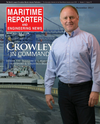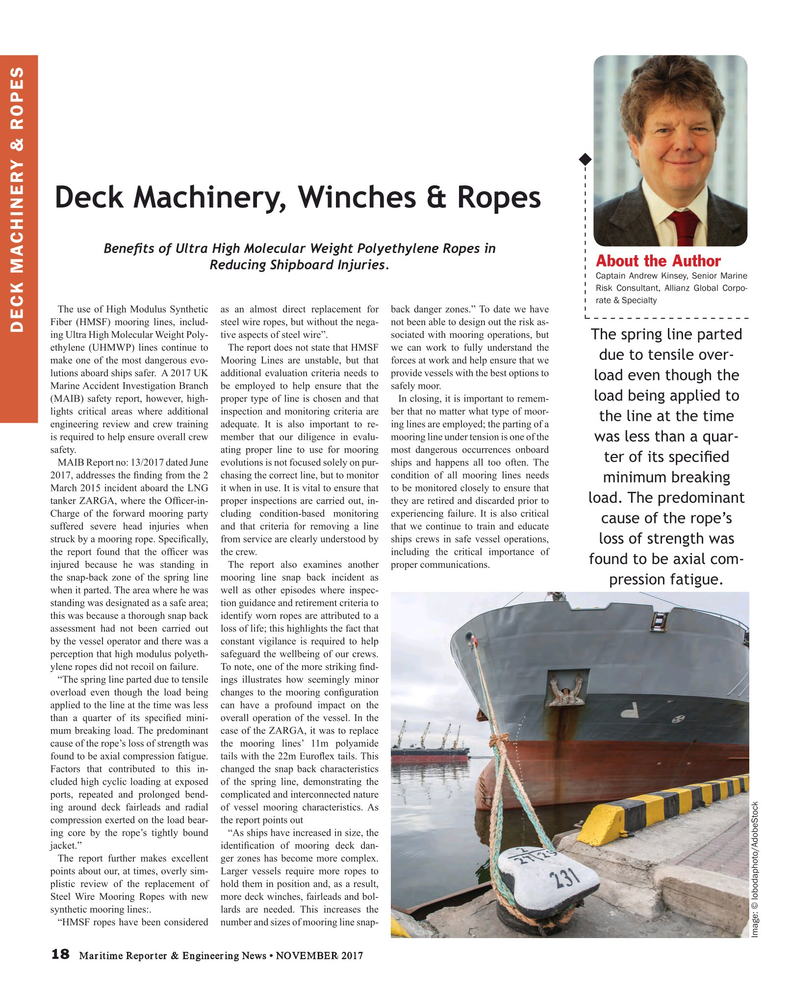
Page 18: of Maritime Reporter Magazine (November 2017)
The Workboat Edition
Read this page in Pdf, Flash or Html5 edition of November 2017 Maritime Reporter Magazine
Deck Machinery, Winches & Ropes
Bene? ts of Ultra High Molecular Weight Polyethylene Ropes in
About the Author
Reducing Shipboard Injuries.
Captain Andrew Kinsey, Senior Marine
Risk Consultant, Allianz Global Corpo- rate & Specialty
The use of High Modulus Synthetic as an almost direct replacement for back danger zones.” To date we have
Fiber (HMSF) mooring lines, includ- steel wire ropes, but without the nega- not been able to design out the risk as-
DECK MACHINERY & ROPES ing Ultra High Molecular Weight Poly- tive aspects of steel wire”. sociated with mooring operations, but
The spring line parted ethylene (UHMWP) lines continue to The report does not state that HMSF we can work to fully understand the due to tensile over- make one of the most dangerous evo- Mooring Lines are unstable, but that forces at work and help ensure that we lutions aboard ships safer. A 2017 UK additional evaluation criteria needs to provide vessels with the best options to load even though the
Marine Accident Investigation Branch be employed to help ensure that the safely moor. load being applied to (MAIB) safety report, however, high- proper type of line is chosen and that In closing, it is important to remem- lights critical areas where additional inspection and monitoring criteria are ber that no matter what type of moor- the line at the time engineering review and crew training adequate. It is also important to re- ing lines are employed; the parting of a is required to help ensure overall crew member that our diligence in evalu- mooring line under tension is one of the was less than a quar- safety. ating proper line to use for mooring most dangerous occurrences onboard ter of its speci? ed
MAIB Report no: 13/2017 dated June evolutions is not focused solely on pur- ships and happens all too often. The 2017, addresses the ? nding from the 2 chasing the correct line, but to monitor condition of all mooring lines needs minimum breaking
March 2015 incident aboard the LNG it when in use. It is vital to ensure that to be monitored closely to ensure that load. The predominant tanker ZARGA, where the Of? cer-in- proper inspections are carried out, in- they are retired and discarded prior to
Charge of the forward mooring party cluding condition-based monitoring experiencing failure. It is also critical cause of the rope’s suffered severe head injuries when and that criteria for removing a line that we continue to train and educate struck by a mooring rope. Speci? cally, from service are clearly understood by ships crews in safe vessel operations, loss of strength was the report found that the of? cer was the crew. including the critical importance of found to be axial com- injured because he was standing in The report also examines another proper communications. the snap-back zone of the spring line mooring line snap back incident as pression fatigue.
when it parted. The area where he was well as other episodes where inspec- standing was designated as a safe area; tion guidance and retirement criteria to this was because a thorough snap back identify worn ropes are attributed to a assessment had not been carried out loss of life; this highlights the fact that by the vessel operator and there was a constant vigilance is required to help perception that high modulus polyeth- safeguard the wellbeing of our crews. ylene ropes did not recoil on failure. To note, one of the more striking ? nd- “The spring line parted due to tensile ings illustrates how seemingly minor overload even though the load being changes to the mooring con? guration applied to the line at the time was less can have a profound impact on the than a quarter of its speci? ed mini- overall operation of the vessel. In the mum breaking load. The predominant case of the ZARGA, it was to replace cause of the rope’s loss of strength was the mooring lines’ 11m polyamide found to be axial compression fatigue. tails with the 22m Euro? ex tails. This
Factors that contributed to this in- changed the snap back characteristics cluded high cyclic loading at exposed of the spring line, demonstrating the ports, repeated and prolonged bend- complicated and interconnected nature ing around deck fairleads and radial of vessel mooring characteristics. As compression exerted on the load bear- the report points out ing core by the rope’s tightly bound “As ships have increased in size, the jacket.” identi? cation of mooring deck dan-
The report further makes excellent ger zones has become more complex. points about our, at times, overly sim- Larger vessels require more ropes to plistic review of the replacement of hold them in position and, as a result,
Steel Wire Mooring Ropes with new more deck winches, fairleads and bol- synthetic mooring lines:. lards are needed. This increases the “HMSF ropes have been considered number and sizes of mooring line snap-
Image: © lobodaphoto/AdobeStock 18 Maritime Reporter & Engineering News • NOVEMBER 2017
MR #11 (18-25).indd 18 MR #11 (18-25).indd 18 11/5/2017 1:03:56 PM11/5/2017 1:03:56 PM

 17
17

 19
19
